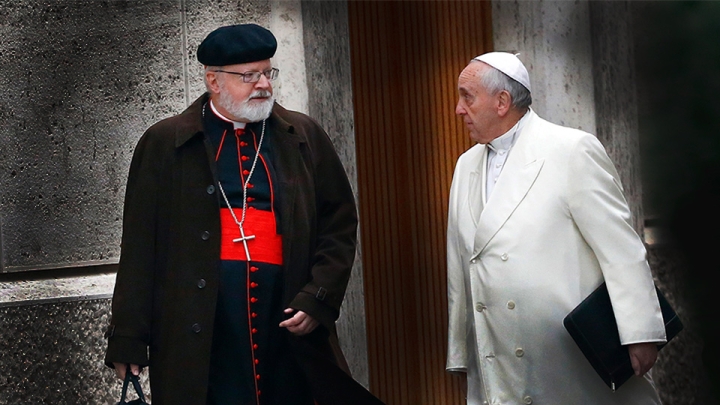When Cardinal Sean O'Malley assumed leadership of the Archdiocese of Boston in 2003, he faced the challenging task of addressing the financial burdens resulting from legal settlements related to the mostly homosexual abuse of minors by priests. As part of the efforts to compensate victims and meet financial obligations, Cardinal O'Malley made the decision to unilaterally close several churches.
The unilateral closures sparked significant backlash from affected communities. Quotes such as: "Parishioners expressed outrage, disappointment, and deep sadness over the closure of their beloved churches. Protests, vigils, and heartfelt pleas were witnessed throughout the archdiocese, as communities fought to save their cherished places of worship" appeared in many local papers.
Prior to the first wave of closures, the Archdiocese of Boston consisted of approximately 357 parishes. During this initial period, a considerable number of parishes were closed, leading to a reduction in their overall count. Based on available data, a Boston Globe article from May 26, 2004, stated: "The Archdiocese of Boston announced the closure of 65 parishes, affecting thousands of parishioners, as part of its efforts to address financial challenges resulting from the abuse scandal."
The collaborative model, in contrast to the unilateral closures, allowed for an apparent participation of all the parishes in the Archdiocese, while all along the mission was to continue the closings. Let us not forget that the closures were motivated, in part, by the need to finance the payments to victims of the abuse scandal.
The backlash was so strong and vigils so damaging, that Cardinal O'Malley introduced the concept of collaboratives in 2010. The implementation of collaboratives emphasized the involvement of the community in decision-making processes. Cardinal O'Malley stated in a Boston Globe article from May 25, 2010: "Collaboratives provide an opportunity for neighboring parishes to come together, share resources, and work as a team in meeting the spiritual needs of their communities."
The collaborative model, in contrast to the unilateral closures, allowed for an apparent participation of all the parishes in the Archdiocese, while all along the mission was to continue the closings. Except this time, with this contrived approach allowing the Cardinal Archbishop of Boston to wash his hands from this terrible result by letting the parishes in each of the Collaboratives do his dirty work of closing the weakest parish. The tyrant was now to be seen as a benevolent father, allowing his children to participate and make the painful decisions.
Let us not forget that the closures were motivated, in part, by the need to finance the payments to victims of the abuse scandal. The sale of assets, such as the only Catholic hospitals in Boston, as well as the archbishop’s mansion to Boston College, were among the measures taken to meet the financial obligations. The Archdiocese of Boston's approach to church closures in the 21st century underwent a significant transformation, from unilateral to “collaborative”.
Since Sean Cardinal O’Malley is one of the nine Cardinals with direct access advising Pope Francis, the novel strategy of the “collaborative” has been now applied to the universal Church under the mode of synodality. Under this model, it will be the Synod that will be doing the Pope’s dirty deed of changing or preparing the path for future changes to the traditional teachings of the Church. A method clever by half, but one that has worked in Boston.
While Pope Francis and his cadre are busy implementing the destruction of the Church guided by the aggiornamento of Vatican II with documents like Traditionis Custodes or Cor Orans, seeking to stall the growth of Traditional Catholicism, they permit the entire German church to apostatize publicly.
While Pope Francis and his cadre are busy implementing the destruction of the Church guided by the aggiornamento of Vatican II with documents like Traditionis Custodes or Cor Orans, seeking to stall the growth of Traditional Catholicism, they permit the entire German church to apostatize publicly. It is as if they are seeking for a “happy medium” between aberrant heretical beliefs and the true faith ushered in by the Synod, now in process. The tyrannical Pope who squashes any vestiges of Tradition is now, at the behest of his Synodal bishops, the benevolent father who will perhaps invoke Alphonsus Liguori, CSsR, as he has done before, noting him for his prudence in avoiding both laxism and excessive rigor, to assuage our concerns and implement his compromises with the True Faith with impunity.
This Pope is not in vain a Jesuit: he is astute, and has learned from his previous mistakes, when he suffered an avalanche of criticism after his disastrous Amoris Laetitia document, provoking the Dubia from learned Cardinals, to which he has yet to respond. This time he has accomplices and can play well the Pontius Pilate role. After all, a Pope must not only be good, but appear to be good; except that in this new world, appearances are all the rage.
The final document of the Synod has already been written, just as the “collaborative” charade accomplished the expected results for the Archdiocese of Boston. The Boston “collaborative” was a staged charade at every step of the way, whereby the implementors from the chancery guided the public meetings to their desired end. They never asked whether “collaboratives” were needed; instead, they belabored the point of how to implement them. Anyone who questioned the need for “collaboratives” was dismissed or criticized as ignorant of reality. So it will be now, with the present Synod. There will be no surprises, the ball will be moved closer and closer to the desired changes in doctrine. The enemy is no longer at the gate; it has made great inroads in our Holy Church and needs to be exorcised with prayer and fasting just as we succeeded in repelling the Muslim hordes at Lepanto. The time for action is now.
Releated from RTV — Pride Month & the Vatican’s World Meeting on Human Fraternity




